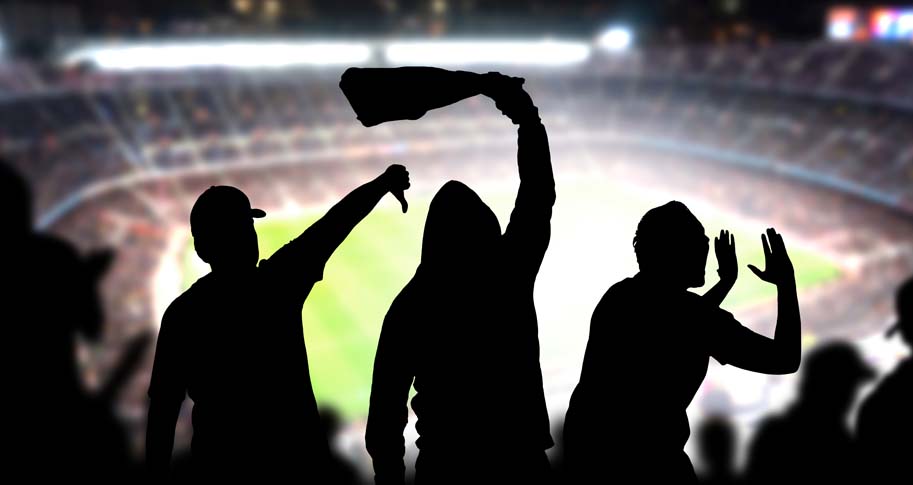
As a thought experiment, let’s consider two kinds of Razorback fans. On the one hand, we have Razorback fans who were nothing but gracious to our Utahn hosts during last season’s BYU game, and on the other, here’s a Razorback fan gloating about Bryce Young’s injury from the Arkansas – Alabama game. Who’s breaking social decorum? Which one makes you proud to wear your Razorback regalia and eager to watch a game in public?
The brands we use reveal some little piece of ourselves, partially by dint of the brand and partially by virtue (or not) of its community of consumers. Sometimes that is a positive thing, but sometimes these relationships can also induce a sense of shame, says University of Arkansas assistant professor, Daniel Villanova. When a brand’s other customers behave poorly, it can make fans feel vicarious shame.
This reflexive withdrawal from a brand or organization we previously wore on our sleeves is the focus of Dr. Villanova’s most recent article, “For Shame! Socially Unacceptable Brand Mentions on Social Media Motivate Consumer Disengagement.” With his coauthor, Ted Matherly, Villanova found across three experiments that socially unacceptable behavior induced consumers with a high connection to a brand to feel vicarious shame and disengage from the brand online. Most important for practitioners, the researchers show that strong brand affiliation isn’t enough to keep customers engaged when other highly connected users misbehave publicly.
Bad Words, Bad Vibes
Socially unacceptable behavior is the transgression of implicit or explicit rules of interaction. In the case of these experiments, Villanova and Matherly specifically focused on the norms around swearing on social media.
As pleasing as these words are to say, some of them are taboo to use, and unhelpfully, that can all be context specific. So, it wasn’t enough for the researchers to just measure swear usage. Villanova and Matherly also measured the impact of those transgressions to see what effect they had on followers and social media engagement.
Across three studies, the researchers looked at this problem of unacceptable behavior and how it impacted others within the brand community. In the first, they used real-world Twitter posts to show that highly connected users disengage due to unseemly behavior, and in their second experiment, Villanova and Matherly uncovered the psychological mechanism, shame, that drove this behavior. Finally, they tested whether managerial moderating could protect brands from this disengagement.
Take Me Out of the Ball Game
For their real-world study, the researchers collected the tweets of all the accounts that were following one of the Twitter accounts for the MLB teams in the 2018 postseason. Their dataset included 15.5 million unique accounts following at least one of the teams, and the researchers observed that over the postseason, more than 210,000 accounts unfollowed an MLB account.
Even though unfollowing events were relatively rare, Villanova and Matherly argue that it represents an important reduction in engagement for the brands. It’s not just the unique accounts social media managers need to consider; each of those unfollowing accounts has followers that are now less likely to see and engage with the brand’s content.
The researchers counted profane tweets that paired profanity with a specific mention of the MLB teams. To measure brand affinity, the researchers used the number of tweets to gauge a particular user’s identification with the brand. Users who did not tweet once about a team during the postseason were considered to have low brand connection, whereas users that tweeted at or above the mean, or 3.5 tweets, were assumed to have high brand connection.
Overall, Villanova and Matherly found that when exposed to socially unacceptable behavior online, both highly and lowly connected users showed disengagement intentions from the brand in question. But the increase in unfollowing due to increasing prevalence of unacceptable behavior was actually stronger for highly connected users than for lowly connected users.
Contextually unacceptable behavior also showed an impact on highly connected users. To measure this, the researchers measured how ratioed tweets impacted users. A ratioed tweet is one that has more replies than likes or retweets, which suggests users are criticizing a user directly rather than endorsing the tweet with a like. For example, the researchers highlighted a tweet that showed an unawareness of the postseason structure. While it did not contain profanity, it was still considered socially unacceptable by MLB fans on Twitter.
The researchers’ data suggest that these more contextually unacceptable tweets affected highly connected users more than lowly connected users, and this is in line with what they found about profanity laced tweets as well. Both kinds of users show an intention to disengage, but more highly connected users were more affected.
Eternal Shame, Nothing but Shame
For their second study, the researchers moved to the lab to isolate the emotions behind user disengagement. So, during the 2019 NFL playoffs, they recruited football fans to fill out a questionnaire just before the Rams and Patriots would play each other in the Super Bowl. Participants answered questions that measured their identification with and ownership of the brand, and they would then be shown one of two tweets, one supporting their chosen team in a family friendly manner and the other engaging in some enthusiastic swearing.
In their experiment, the researchers found that when self-brand connection was low, the more socially unacceptable tweet did not increase the individual’s disengagement intention compared to the less socially unacceptable tweet. On the other hand, when self-brand connection was high, those participants did show a greater intention to disengage from the brand when they were exposed to the more socially unacceptable tweet.
In short, if you’re a fair-weather Rams fan or just a casual observer, you may not mind a tweet swearing about a missed call by the officials; you’re already not strongly committed to the brand, and you’re definitely not the ‘Rams guy’ in the office. On the other hand, if you’re a diehard Rams fan who loved them even when they were 1-15, then that same tweet might bother you because now that tweet at least partially speaks for you too.
A Public Forum
In their final experiment, Villanova and Matherly recruited another crop of participants, who filled out a questionnaire measuring their attachment to several sportswear brands like Nike, Puma, and Adidas. They were then shown a Reddit post that either expressed disappointment with another user’s post or one that hurled a profanity laced invective at the user for disagreeing.
To further explore how vicarious shame affected participants, users were also shown the socially unacceptable posts and told that moderators had removed the post and banned the user for their misbehavior.
This study further supported the researchers’ initial findings. When exposed to unacceptable behavior, users are more likely to disengage because of their feelings of shame. But, when they knew the brand reacted to the bad behavior by having the original poster banned from the community, it did help alleviate some of the disengagement intention, though not entirely. Effective moderation helps, but it doesn’t solve everything; in short, you may stay on Reddit, but your inkling to leave the platform may still be there and may still surface if something else happens.
The researchers also measured how participants felt and continued to feel about the brands in question. Even when participants indicated that they were likely to disengage from the online community, their opinions of the brand remained consistent.
Are Words Violence?
Whether or not words actually constitute violence, Villanova and Matherly’s research suggests they have a measurable impact upon others and their feelings of shame. And as the researchers note, their work offers interesting wrinkles to the findings of other research teams.
So, while there are prior suggestions for brand managers to cultivate strong relationships with customers, Villanova and Matherly’s work shows that the dividends paid by those relationships may be limited. Furthermore, though higher brand identification may induce customers to purchase higher end products, Villanova and Matherly have shown that strong brand identification can also be a liability when other customers behave poorly.
As researchers turn towards questions of consumption-based offenses – that is, when we realize consuming a product challenges an aspect of our identity such as our values or self-view – Daniel Villanova’s work asks some hard questions of us as consumers. What is our responsibility in cultivating communities around the brands we love? Is the shame we feel when we see someone else in the community misbehaving due to their behavior or some deep-seated revulsion to ourselves and our consumptive patterns?







